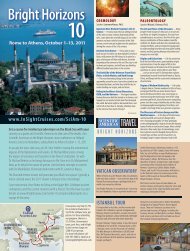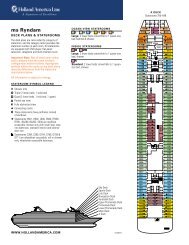Croatian cultural heritage - Business - Hrvatska turistiÄka zajednica
Croatian cultural heritage - Business - Hrvatska turistiÄka zajednica
Croatian cultural heritage - Business - Hrvatska turistiÄka zajednica
Create successful ePaper yourself
Turn your PDF publications into a flip-book with our unique Google optimized e-Paper software.
43<br />
church interior was decorated with frescoes in 1602 (36), is<br />
situated further inland into the the karst hills of the southeastern<br />
desert of the Velebit mountain in the valley of the<br />
river Krupa (32). In the Ravni Kotari and Bukovica districts<br />
there are many other smaller, old churches (41), harmoniously<br />
integrated with the surrounding landscape between<br />
the slopes of Velebit and the sea coast (35).<br />
The numerous ZADAR ISLANDS have a valuable historical<br />
<strong>heritage</strong>, and the area of Zadar is exceptionally indented<br />
(55), which makes it especially interesting for sailing. On<br />
the island of Pašman, there are two valuable monasteries - a<br />
Franciscan monastery from the 14th - 18th century (48) and<br />
Benedictine Ćokovac, on the hill above Tkon, from the 12th<br />
- 15th century (49). The latter is the only active Benedictine<br />
monastery in Croatia and holds the most notable and valuable<br />
collection of old paintings (47). Next to the island Ugljan<br />
on the smaller island of Galevac is a beautiful monastery of<br />
the Franciscan Third Order from the 15th century (51).<br />
On the islands of Zadar there are many old forts and towers,<br />
such as the Kaštelina on Vir (50) or Toreta, a viewpoint<br />
on Silba (53), and the cape of Veli rat on Dugi Otok (Long<br />
Island) has one of the most beautiful <strong>Croatian</strong> lighthouses<br />
(43). However, the most valuable <strong>cultural</strong> <strong>heritage</strong> of the Zadar<br />
islands is found on Pag, the island of salt, cheese and<br />
lace. It is connected to the mainland by a bridge and is surrounded<br />
with well preserved fortified towers (45 & 52). Today's<br />
city centre originates from the 15th century Pag (46),<br />
organised as an orthogonal grid of streets and squares, an<br />
idea probably originating from the famous <strong>Croatian</strong> sculptor<br />
and architect, Juraj Dalmatinac. At its heart is the church of<br />
the Assumption of the Blessed Virgin Mary from the same<br />
period (44).<br />
84
















